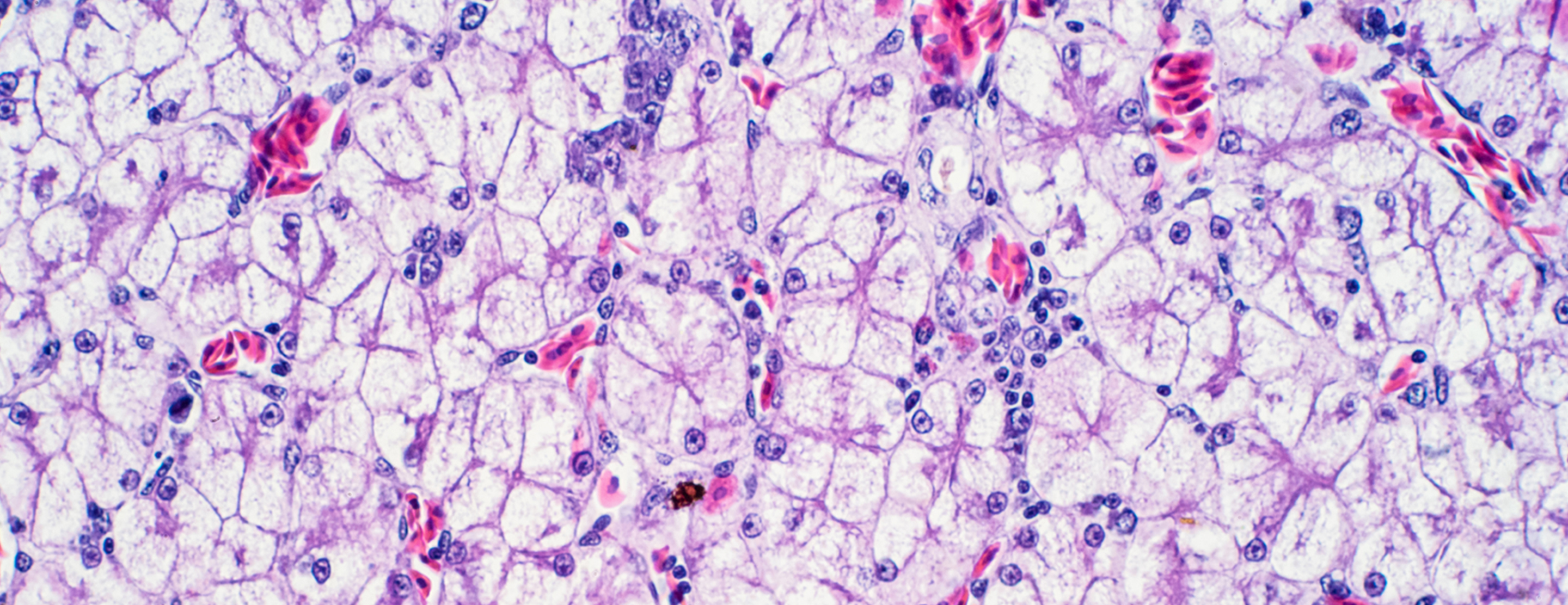
Liver biopsy
Definition
A liver
Alternative Names
Biopsy - liver; Percutaneous biopsy; Needle biopsy of liver
How the Test is Performed
Most of the time, the test is done in the hospital. Before the test is done, you may be given a medicine to prevent pain or to calm you (sedative).
The biopsy may be done through the abdominal wall:
- You will lie on your back with your right hand under your head. You need to stay as still as you can.
- The health care provider will find the correct spot for the biopsy needle to be inserted into the liver. This is often done by using ultrasound.
- The skin is cleaned, and numbing medicine is injected into the area using a small needle.
- A small cut is made, and the biopsy needle is inserted.
- You will be told to hold your breath while the biopsy is taken. This is to reduce the chance of damage to the lung or liver.
- The needle is removed quickly.
- Pressure will be applied to stop the bleeding. A bandage is placed over the insertion site.
The procedure can also be done by inserting a needle into the jugular vein.
- If the procedure is performed this way, you will lie on your back.
- X-rays will be used to guide the provider to the vein.
- A special needle and catheter (thin tube) is used to take the biopsy sample.
If you receive sedation for this test, you will need someone to drive you home.
How to Prepare for the Test
Tell your provider about:
- Bleeding problems
- Drug allergies
- Medicines you are taking including herbs, supplements, or medicines you bought without a prescription
- Whether you are pregnant
You must sign a consent form. Blood tests are sometimes done to test your blood's ability to clot. You will be told not to eat or drink anything for the 8 hours before the test.
For infants and children:
The preparation needed for a child depends on the child's age and maturity. Your child's provider will tell you what you can do to prepare your child for this test.
How the Test will Feel
You will feel a stinging pain when the anesthetic is injected. The biopsy needle may feel like deep pressure and dull pain. Some people feel this pain in the shoulder.
Why the Test is Performed
The biopsy helps diagnose many
The biopsy also helps detect:
- Cancer
- Infections
- The cause of abnormal levels of liver enzymes that have been found in blood tests
- The cause of an unexplained liver enlargement
Normal Results
The liver tissue is normal.
What Abnormal Results Mean
The biopsy may reveal a number of liver diseases, including
This test also may be performed for:
Alcoholic liver disease (fatty liver, hepatitis, or cirrhosis)Amebic liver abscess Autoimmune hepatitis Biliary atresia - Chronic active hepatitis
- Chronic persistent hepatitis
Disseminated coccidioidomycosis Hemochromatosis Hepatitis B Hepatitis C Hepatitis D Hepatocellular carcinoma Hodgkin lymphoma Non-alcoholic fatty liver disease Non-Hodgkin lymphoma Primary biliary cirrhosis , now called primary biliary cholangitisPyogenic liver abscess Reye syndrome Sclerosing cholangitis Wilson disease
Risks
Risks may include:
Collapsed lung - Complications from the sedation
- Injury to the gallbladder or kidney
- Internal bleeding
References
Bedossa P, Paradis V, Zucman-Rossi J. Cellular and molecular techniques. In: Burt AD, Ferrell LD, Hubscher SG, eds. MacSween's Pathology of the Liver. 7th ed. Philadelphia, PA: Elsevier; 2018:chap 2.
Berk PD, Korenblat KM. Approach to the patient with jaundice or abnormal liver tests. In: Goldman L, Schafer AI, eds. Goldman-Cecil Medicine. 25th ed. Philadelphia, PA: Elsevier Saunders; 2016:chap 147.
Chernecky CC, Berger BJ. Liver biopsy (percutaneous liver biopsy) - diagnostic. In: Chernecky CC, Berger BJ, eds. Laboratory Tests and Diagnostic Procedures. 6th ed. Philadelphia, PA: Elsevier Saunders; 2013:727-729.
Squires JE, Balistreri WF. Manifestations of liver disease. In: Kliegman RM, Stanton BF, St. Geme JW, Schor NF, eds. Nelson Textbook of Pediatrics. 20th ed. Philadelphia, PA: Elsevier; 2016:chap 355.
Wedemeyer H. Hepatitis C. In: Feldman M, Friedman LS, Brandt LJ, eds. Sleisenger and Fordtran's Gastrointestinal and Liver Disease. 10th ed. Philadelphia, PA: Elsevier Saunders; 2016:chap 80.
Review Date: 01/01/2019
The information provided herein should not be used during any medical emergency or for the diagnosis or treatment of any medical condition. A licensed physician should be consulted for diagnosis and treatment of any and all medical conditions. Call 911 for all medical emergencies. Links to other sites are provided for information only -- they do not constitute endorsements of those other sites. Copyright ©2019 A.D.A.M., Inc., as modified by University of California San Francisco. Any duplication or distribution of the information contained herein is strictly prohibited.
Information developed by A.D.A.M., Inc. regarding tests and test results may not directly correspond with information provided by UCSF Health. Please discuss with your doctor any questions or concerns you may have.





